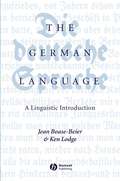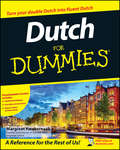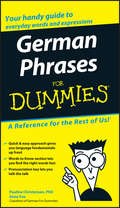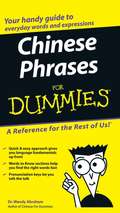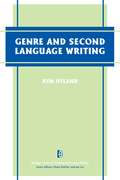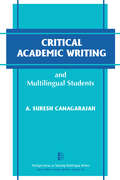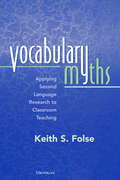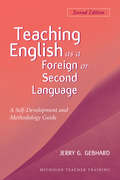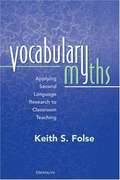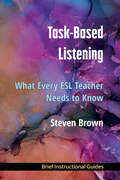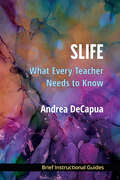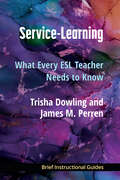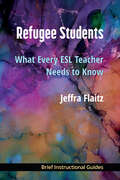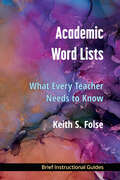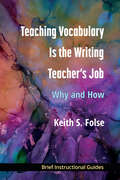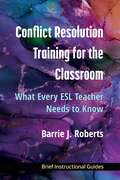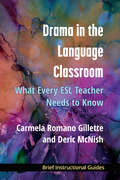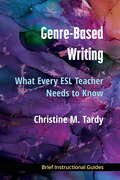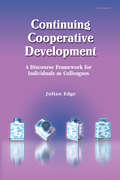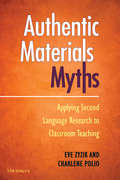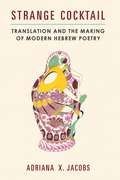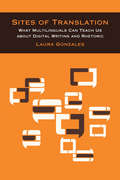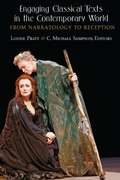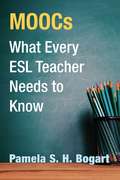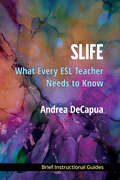- Table View
- List View
The German Language: A Linguistic Introduction
by Jean Boase-Beier Ken R. LodgeThe German Language introduces students of German to a linguistic way of looking at the language. Written from a Chomksyan perspective, this volume covers the basic structural components of the German language: syntax, morphology, phonetics, phonology, and the lexicon. Explores the linguistic structure of German from current theoretical perspectives. Written from a Chomksyan perspective, this volume covers the basic structural components of the German language: syntax, morphology, phonetics, phonology, and the lexicon. Serves as a valuable resource for students of German language and literature and for linguists with little or no background in the language. Includes exercises, definitions of key terms, and suggestions for further reading.
Dutch For Dummies
by Margreet KwakernaakDutch is spoken by 23 million people, mainly in the Netherlands and Belgium, and is an official EU language. For English speakers, written Dutch can be fairly straightforward to pick up, although the pronunciation can be more of a challenge. This simple guidebook and audio CD covers Dutch grammar, pronunciation and everyday phrases, making this vibrant language more accessible to English speakers – whether you’re just visiting or planning to stay on a long-term basis. Dutch For Dummies is the essential guide for everyone from students and holidaymakers, to those wanting to speak Dutch for business purposes. From numbers and vocabulary to greetings, popular expressions and proper etiquette, this clear, easy-to-follow guide will have you speaking Dutch like a native in no time. Dutch For Dummies includes: Audio CD to assist learning Introductory grammar and vocabulary Meeting and getting to know people Dining out, shopping, leisure time and the workplace Dealing with emergencies Tips on how to pick up Dutch quickly Note: CD files are available to download when buying the eBook version
German Phrases For Dummies
by Paulina Christensen Anne FoxHundreds of useful phrases at your fingertips Speak German - instantly! Traveling to Germany but don't know German? Taking German at school but need to kick up your conversation skills? Don't worry! This handy little phrasebook will have you speaking German in no time. Discover how to: Get directions, shop, and eat out Talk numbers, dates, time, and money Chat about family and work Discuss sports and the weather Deal with problems and emergencies
Chinese Phrases For Dummies
by Wendy AbrahamHundreds of useful phrases at your fingertips Speak Chinese - instantly! Traveling to China but don't know Chinese? Taking Chinese at school but need to kick up your conversation skills? Don't worry! This handy little phrasebook will have you speaking Chinese in no time. Discover how to Get directions, shop, and eat out Talk numbers, dates, time, and money Chat about family and work Discuss sports and the weather Deal with problems and emergencies
Genre and Second Language Writing: Genre And Second Language Writing (The Michigan Series on Teaching Multilingual Writers)
by Ken HylandSecond language students not only need strategies for drafting and revising to write effectively, but also a clear understanding of genre so that they can appropriately structure their writing for various contexts. Over that last decade, increasing attention has been paid to the notion of genre and its central place in language teaching and learning. Genre and Second Language Writing enters into this important debate, providing an accessible introduction to current theory and research in the area of written genres-and applying these understandings to the practical concerns of today's EFL/ESL classroom. Each chapter includes discussion and review questions and small-scale practical research activities. Like the other texts in the popular Michigan Series on Teaching Multilingual Writers, this book will interest ESL teachers in training, teacher educators, current ESL instructors, and researchers and scholars in the area of ESL writing.
Critical Academic Writing and Multilingual Students: Critical Academic Writing And Multilingual Students (The Michigan Series on Teaching Multilingual Writers)
by Attelstan Suresh CanagarajahThe critical approach to L2 writing is arguably one of the most significant recent developments in L2 writing pedagogy. A. Suresh Canagarajah provides a thorough discussion of this topic in Critical Academic Writing and Multilingual Students. This volume facilitates teacher self-reflection and enables readers to better understand the motivations and pedagogical implications--especially for L2 writing--of a more openly pedagogical approach. Critical Academic Writing and Multilingual Students explains what it means to commit to an academic pedagogy, in terms of form, self, content, and community--and what it can accomplish in the L2 writing classroom. It's a guide for writing teachers who wish to embark on a journey toward increased critical awareness of the role they play, or potentially could play, in the lives of their students.
Vocabulary Myths: Applying Second Language Research to Classroom Teaching
by Keith S. FolseIn Vocabulary Myths, Keith S. Folse breaks down the teaching of second language vocabulary into eight commonly held myths. In debunking each myth, he introduces the myth with a story based on his 25 years of teaching experience (in the United States and abroad), continues with a presentation of what empirical research has shown on the topic, and finishes with a list of what teachers can do in their classrooms to facilitate true vocabulary acquisition. The goal of Vocabulary Myths is to foster a paradigm shift that correctly views vocabulary as fundamental in any second language learning process and demonstrates that research supports this goal-that in fact there is a wealth of empirical evidence to support these views. In addition, an important theme is that teachers have overestimated how much vocabulary students really understand, and as a result, the so-called "comprehensible input" is neither comprehensible nor input. The second language vocabulary acquisition myths reexamined in this book are: *In learning another language, vocabulary is not as important as grammar or other areas. *Using word lists to learn L2 vocabulary is unproductive. *Presenting new vocabulary in semantic sets facilitates learning. *The use of translations to learn new vocabulary should be discouraged. *Guessing words from context is an excellent strategy for learning L2 vocabulary. *The best vocabulary learners make use of one or two really specific vocabulary learning strategies. *The best dictionary for L2 learners is a monolingual dictionary. *Teachers, textbooks, and curricula cover L2 vocabulary adequately.
Teaching English as a Foreign or Second Language, Second Edition: A Teacher Self-Development and Methodology Guide
by Jerry G. GebhardTeaching English as a Foreign or Second Language, Second Edition, is designed for those new to ESL/EFL teaching and for self-motivated teachers who seek to maximize their potential and enhance the learning of their students. This guide provides basic information that ESL/EFL teachers should know before they start teaching and many ideas on how to guide students in the skills of listening, speaking, reading, and writing. It stresses the multifaceted nature of teaching the English language to non-native speakers and is based on the real experiences of teachers. The second edition of Teaching English as a Foreign or Second Language includes a wider range of examples to coincide with a variety of teaching contexts-from K-12 schools, to university intensive language programs and refugee programs. It is also updated with discussions of technology throughout, and it considers ways in which technology can be used in teaching language skills. Sources for further study are included in each chapter and in the appendixes.
Vocabulary Myths: Applying Second Language Research to Classroom Teaching (PDF)
by Keith S. FolseIn Vocabulary Myths, Keith S. Folse breaks down the teaching of second language vocabulary into eight commonly held myths. In debunking each myth, he introduces the myth with a story based on his 25 years of teaching experience (in the United States and abroad), continues with a presentation of what empirical research has shown on the topic, and finishes with a list of what teachers can do in their classrooms to facilitate true vocabulary acquisition. The goal of Vocabulary Myths is to foster a paradigm shift that correctly views vocabulary as fundamental in any second language learning process and demonstrates that research supports this goal-that in fact there is a wealth of empirical evidence to support these views. In addition, an important theme is that teachers have overestimated how much vocabulary students really understand, and as a result, the so-called "comprehensible input" is neither comprehensible nor input. The second language vocabulary acquisition myths reexamined in this book are: *In learning another language, vocabulary is not as important as grammar or other areas. *Using word lists to learn L2 vocabulary is unproductive. *Presenting new vocabulary in semantic sets facilitates learning. *The use of translations to learn new vocabulary should be discouraged. *Guessing words from context is an excellent strategy for learning L2 vocabulary. *The best vocabulary learners make use of one or two really specific vocabulary learning strategies. *The best dictionary for L2 learners is a monolingual dictionary. *Teachers, textbooks, and curricula cover L2 vocabulary adequately.
Task-Based Listening: What Every ESL Teacher Needs to Know
by Steven BrownAre you looking for activities to use in your listening classes beyond asking students to answer comprehension questions? In Task-Based Listening, author Steven Brown defines task-based listening (TBL) and describes how to build a task-based listening program, how to create a task-based listening lesson, ways to activate vocabulary acquisition and improve grammatical knowledge, and the links between listening and pronunciation. In addition, he covers the ways that metacognitive strategies can assist students when listening, the advantages of extensive listening, and the benefits of interactive listening. Readers will find specific tips and suggestions for using these concepts in the classroom.
SLIFE: What Every Teacher Needs to Know
by Andrea DeCapuaSLIFE: What Every Teacher Needs to Know helps readers deepen their understanding of Students with Limited or Interrupted Formal Education (SLIFE). Because of their limited, greatly interrupted, or sometimes nonexistent participation in formal education, SLIFE face challenges in the classroom that go beyond language and content. Often SLIFE need to develop basic literacy skills and foundational subject-area knowledge, as well as to learn how to engage in the discourse and practices of formal educational settings. So what can teachers do to help these students succeed and to recognize and honor their knowledge, skills, and cultural capital? SLIFE: What Every Teacher Needs to Know centers around four guidelines for teaching SLIFE: question assumptions, foster two-way communication, explicitly teach school tasks and academic ways of thinking, and promote project-based learning. Discussion of the Mutually Adaptive Learning Paradigm (MALP), is also included.
Service-Learning: What Every ESL Teacher Needs to Know
by James Perren Trisha DowlingService-Learning: What Every ESL Teacher Needs to Know gives practical information on implementing service-learning in the field of TESOL. Service-learning—"the accomplishment of tasks that meet genuine human needs in combination with conscious educational growth"—has developed into a pedagogical approach that incorporates student learning and reflection with curricular concepts while partnering with community organizations. Following an overview of service-learning in the field of TESOL, this text includes sections on incorporating service-learning in an ESL course, finding appropriate community partnerships, making decisions about culture- and language-based lessons, assessing students, and making the experience meaningful. Also included are four specific strategies to help readers make the case for service-learning to administrators.
Refugee Students: What Every ESL Teacher Needs to Know
by Jeffra FlaitzRefugee Students offers a compassionate yet practical guide for anyone who wants to better understand their refugee students, including their backgrounds, their challenges, and their strengths. Author Jeffra Flaitz provides a research- and fact-based guide to teaching refugees in today’s U.S. educational system. She discusses the different categories of immigrants, the diversity of refugees, how they may differ from other ESL students, and the risks they may face. Each section is followed by a list of what educators can do for these students.
Academic Word Lists: What Every Teacher Needs to Know
by Keith S. FolseIn Academic Word Lists, Keith Folse explains how various lists like the Academic Word List (AWL) have become popular tools in the ESL classroom for teaching vocabulary. Following a discussion on the importance of teaching vocabulary, Folse explains why word lists are useful in language learning and how they can help address the lexical gap. He also outlines what words are on the AWL, how the word families are selected, and what teachers should know about other word lists. The book also includes 10 suggestions for using academic word lists in the classroom, including how to use vocabulary notebooks.
Teaching Vocabulary Is the Writing Teacher's Job: Why and How
by Keith S. FolseWhile most teachers acknowledge the importance of vocabulary in learning a new language, many assume a reading class or other teacher will cover vocabulary. Yet vocabulary plays an essential role in good writing, especially academic writing. Teaching Vocabulary Is the Writing Teacher’s Job explores the serious nature of ESL students’ lexical plight and looks at vocabulary in relation to reading, speaking, listening, and writing proficiency. It also examines the role of vocabulary in ESL writing assessment. In the conclusion, author Keith Folse discusses eight research-based suggestions for writing teachers, including encouraging students to become vocabulary detectives, teaching collocations, testing vocabulary, and teaching paraphrasing and summarizing.
Conflict Resolution Training for the Classroom: What Every ESL Teacher Needs to Know
by Barrie RobertsESL instructors without a background in conflict resolution (CR) who teach intermediate to advanced courses at colleges, universities, or in Intensive English Programs, may want to provide students with valuable negotiation and mediation skills. Author Barrie J. Roberts is an experienced ESL teacher, lawyer, mediator, and Alternative Dispute Resolution (ADR) Administrator for southern California Superior Courts. In this book, she draws upon her experience using these activities in a variety of ESL settings and courses with students from all over the world to inspire other ESL teachers to add CR approaches to their activities, lessons, and courses. Following an introduction to conflict resolution, Conflict Resolution Training for the Classroom shows how much of the teaching of CR is similar to teaching ESL. It outlines ways to apply negotiation and mediation to ESL activities, how to prevent and resolve conflicts, how to use specific types of role-plays to address conflicts, and how to design successful activities. The book also includes a list of resources and sample syllabi.
Drama in the Language Classroom: What Every ESL Teacher Needs to Know
by Carmela Romano Gillette Deric McNishDrama in the Language Classroom weaves together cutting-edge research and practices from the fields of theater and TESOL. After providing an overview of how drama can be used in the language classroom, Carmela Romano Gillette (a TESOL expert) and Deric McNish (an expert in actor training) present a collection of resources teachers need to begin using drama, including practical classroom-tested and evidence-based techniques. They show how theater, performance, and improvisation can help students build confidence, develop a deeper context for speaking, and create authentic opportunities for language use. In addition, they outline the para- and extra-linguistic techniques that can improve expression and meaningful communication. Each section includes sample activities, such as script analysis for improving fluency, and assessment suggestions. Readers do not need to have experience with performance or drama to learn how to incorporate these practices into the ESL classroom.
Genre-Based Writing: What Every ESL Teacher Needs to Know
by Christine TardyIn Genre-Based Writing, author Christine Tardy defines genre and genre-based writing instruction and the five principles of a genre-based pedagogy. She then explains how to design genre-based writing activities. By discussing the genre-related practices and social and rhetorical aspects of genre, she is able to outline strategies for exploring rhetorical moves and playing with genre form in the classroom. In addition, the book provides general tips for bringing a genre approach into the writing classroom as well as several application activities and specific suggestions for classroom tasks.
Continuing Cooperative Development: A Discourse Framework for Individuals as Colleagues
by Julian EdgeIn Continuing Cooperative Development, a series of guided tasks helps the reader acquire specific skills of listening and responding that, in turn, help a speaker to express and articulate thoughts and plans that lie just beyond what they knew that they knew. By adopting a certain style of speaking and listening to colleagues for agreed periods of time, motivated professionals can take individual control of their own development and increase the feeling of collegiality in their workplace. Continuing Cooperative Development draws on Edge's experience of more than ten years using this framework worldwide and provides authentic examples to guide the reader. This interactive framework is demonstrated in the book as part of a reflective teaching approach in response to everyday classroom problems, and also as part of a more formal, action-research approach to the formulation of local educational theory. The key theme of this book is the power of non-judgmental discourse to facilitate the development of ideas and action, accessing both cognitive and emotional intelligence. The transcribed and interpreted data of authentic interactions from the Americas, Europe, and Asia serve as evidence for the argument and as guidelines for implementation. The work is set in the field of TESOL, although its relevance reaches across discipline boundaries. The teachers featured in the book have duties ranging from the instruction of young learners to the supervision of doctoral research. The common denominator is that these people are motivated educators, committed to extending their own understanding and developing their own style of being an aware professional.
Authentic Materials Myths: Applying Second Language Research to Classroom Teaching
by Eve Zyzik Charlene PolioThe use of authentic materials in language classrooms is sometimes discussed as a reliable way to expose students to the target language, but there is also disagreement regarding what kinds of authentic materials should be used, when they should be used, and how much of the curriculum should revolve around them. This volume in the Myths series explores the research related to the use of authentic materials and the ways that authentic materials may be used successfully in the classroom. Like others in the Myths series, this book combines research with good pedagogical practices. The myths examined in this book are: Authentic texts are inaccessible to beginners. Authentic texts cannot be used to teach grammar. Shorter texts are more beneficial for language learners. Activating background knowledge or making a word list is sufficient to prepare students for authentic texts. Authentic texts can be used to teach only listening and reading. Modifying or simplifying authentic texts always helps language learners. For learners to benefit from using authentic texts, the associated tasks must also be authentic. The Epilogue explores the challenges of using authentic texts in the classroom and calls for more research.
Strange Cocktail: Translation and the Making of Modern Hebrew Poetry (Michigan Studies In Comparative Jewish Cultures)
by Adriana X. JacobsFor centuries, poets have turned to translation for creative inspiration. Through and in translation, poets have introduced new poetic styles, languages, and forms into their own writing, sometimes changing the course of literary history in the process. Strange Cocktail is the first comprehensive study of this phenomenon in modern Hebrew literature of the late nineteenth century to the present day. Its chapters on Esther Raab, Leah Goldberg, Avot Yeshurun, and Harold Schimmel offer close readings that examine the distinct poetics of translation that emerge from reciprocal practices of writing and translating. Working in a minor literary vernacular, the translation strategies that these poets employed allowed them to create and participate in transnational and multilingual poetic networks. Strange Cocktail thereby advances a comparative and multilingual reframing of modern Hebrew literature that considers how canons change and are undone when translation occupies a central position—how lines of influence and affiliation are redrawn and literary historiographies are revised when the work of translation occupies the same status as an original text, when translating and writing go hand in hand.
Sites of Translation: What Multilinguals Can Teach Us about Digital Writing and Rhetoric (Sweetland Digital Rhetoric Collaborative)
by Laura GonzalesWinner of the 2016 Sweetland Digital Rhetoric Collaborative Book Prize Sites of Translation illustrates the intricate rhetorical work that multilingual communicators engage in as they translate information for their communities. Blending ethnographic and empirical methods from multiple disciplines, Laura Gonzales provides methodological examples of how linguistic diversity can be studied in practice, both in and outside the classroom, and provides insights into the rhetorical labor that is often unacknowledged and made invisible in multilingual communication. Sites of Translation is relevant to researchers and teachers of writing as well as technology designers interested in creating systems, pedagogies, and platforms that will be more accessible and useful to multilingual audiences. Gonzales presents multilingual communication as intellectual labor that should be further valued in both academic and professional spaces, and supported by multilingual technologies and pedagogies that center the expertise of linguistically diverse communicators.
Engaging Classical Texts in the Contemporary World: From Narratology to Reception
by Louise H. Pratt C. M SampsonContemporary classicists often find themselves advocating for the value and relevance of Greco-Roman literature and culture, whether in the classroom, or social media, or newsprint and magazines. In this collection, twelve top scholars apply major critical approaches from other academic fields to open new channels for dialogue between ancient texts and the contemporary world. This volume considers perennial favorites of classical literature—the Iliad and Odyssey, Greek tragedy, Roman comedy, the Argonautica, and Ovid’s Metamorphoses—and their influence on popular entertainment from Shakespeare’s plays to Hollywood’s toga films. It also engages with unusual and intriguing texts across the centuries, including a curious group of epigrams by Artemidorus found on the island sanctuary of Thera, mysterious fragments of two Aeschylean tragedies, and modern-day North African novels. These essays engage an array of theoretical approaches from other fields—narratology, cognitive literary theory, feminist theory, New Historicist approaches to gender and sexuality, and politeness theory—without forsaking more traditional philological methods. A new look at hospitality in the Argonautica shows its roots in the changed historical circumstances of the Hellenistic world. The doubleness of Helen and her phantom in Euripides’ Helen is even more complex than previously noted. Particularly illuminating is the recurrent application of reception studies, yielding new takes on the ancient reception of Homer by Apollonius and of Aeschylus by Macrobius, the reception of Plautus by Shakespeare, and more contemporary examples from the worlds of cinema and literature. Students and scholars of classics will find much in these new interpretations and approaches to familiar texts that will expand their intellectual horizons. Specialists in other fields, particularly English, comparative literature, film studies, and gender and sexuality studies, will also find these essays directly relevant to their work.
MOOCs: What Every ESL Teacher Needs to Know
by Pamela BogartPamela Bogart, an instructor at the University of Michigan's English Language Institute, explains the ins and outs of massive open online courses (MOOCs), particularly those that can support language learning. The author begins by describing what a MOOC is; she then identifies the various types of MOOCs and their pedagogical benefits and shows how MOOCs can aid in the language learning process and offer students a more richly textured blended learning experience. The text concludes with tips for creating and designing a MOOC. Each section includes an Exploration Task that invites readers to deepen their personal understanding of and experience with MOOCs.
SLIFE: What Every Teacher Needs to Know
by Andrea DeCapuaSLIFE: What Every Teacher Needs to Know helps readers deepen their understanding of Students with Limited or Interrupted Formal Education (SLIFE). Because of their limited, greatly interrupted, or sometimes nonexistent participation in formal education, SLIFE face challenges in the classroom that go beyond language and content. Often SLIFE need to develop basic literacy skills and foundational subject-area knowledge, as well as to learn how to engage in the discourse and practices of formal educational settings. So what can teachers do to help these students succeed and to recognize and honor their knowledge, skills, and cultural capital? SLIFE: What Every Teacher Needs to Know centers around four guidelines for teaching SLIFE: question assumptions, foster two-way communication, explicitly teach school tasks and academic ways of thinking, and promote project-based learning. Discussion of the Mutually Adaptive Learning Paradigm (MALP), is also included.
